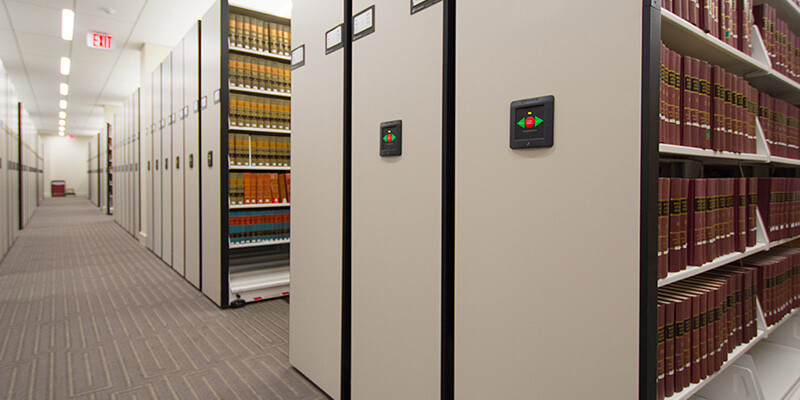Even in today's digital world, paper and other flammable materials are still part of everyday life in almost every industry. Planning for the worst may not be fun, but it's smart — and that's where fireproof storage comes in. It's a key piece of any solid fire protection strategy.
Key Fire Protection Codes to Consider
Fire protection is everyone's concern, from architects and interior designers to building owners and employees. Even code officials and insurance companies have a stake in the game. At the end of the day, they all share the same three goals:
- Minimize the chances of a fire happening
- Limit the damage if a fire does occur
- Protect the building, the people inside, and its contents
When planning for fireproof storage, it's essential to consider various codes and compliance requirements, including:
- International Building Code (IBC): The IBC provides comprehensive guidelines for the construction and design of storage facilities and buildings, emphasizing fire safety and structural integrity.
- National Fire Protection Association (NFPA): The NFPA publishes over 300 codes and standards, including recommendations for automatic sprinkler systems in libraries and collection storage areas to mitigate fire risks.
- U.S. National Archives & Records Administration (NARA): NARA mandates that facilities housing federal records must limit fire damage to a maximum of 300 cubic feet of records in a single fire event.

But fire code compliance is just one piece of the puzzle when building a new storage space, or renovating or repurposing an old one. Engineers, architects, designers, and project managers already have plenty to juggle. That's where storage experts come in, offering guidance and ensuring your storage solutions reflect the latest fire protection standards and best practices.
How Fire Protection Shapes Storage Design
Storage planners put fire protection front and center when designing solutions tailored to clients' needs — whether for libraries, museums, federal buildings, or business offices. This requires a deep understanding of how fire protection standards influence storage design, including:
- The combustibility of both the materials being stored and the storage equipment itself
- Different considerations for mobile storage solutions versus static shelving placed against walls
- The height of storage equipment relative to ceilings and ceiling-mounted sprinkler systems
- The need for fire stops, which use storage materials or create gaps to allow water to reach and suppress a fire effectively
Fireproof Storage in High-Bay Applications
High-bay fireproof storage is great for saving space, making the most of vertical storage instead of taking up extra square footage. But with added height comes added fire protection concerns.
Typically, planners call for both ceiling and intermediate-level sprinklers to keep materials safe. To see if ceiling sprinklers alone could do the job, Spacesaver put its high-bay storage to the test.

In a controlled fire test, they used Early Suppression Fast Response (ESFR) sprinklers with a 33-foot-tall Spacesaver mobile records storage system. The resulting fire damage was minimal — out of 11,500 cubic feet of stored records, less than 100 cubic feet were lost or irrecoverable.
This test confirmed that ESFR sprinklers are effective for high-bay storage applications. Plus, using them can save costs by eliminating the need for automatic roof smoke and heat vents in storage facilities.
Tamping Out Other Fire-Related Concerns
Fire safety isn't just about sprinklers. Spacesaver builds its mobile carriages and shelving from non-combustible steel or aluminum, helping to minimize fire risks. And for areas with stricter fire codes? Fire-retardant wood end panels, steel end panels, and flooring between carriage rails are all available options.
When the University of South Carolina's Law Library moved into a smaller space, they needed a smarter way to store over 300,000 volumes while still making room for student study areas and collaboration.

Patterson Pope's designers helped them find the perfect fit — a 27,000-linear-foot electronic high-density mobile shelving system installed in the library's 8,000-square-foot basement. Along with maximizing storage, the system includes safety features like "Fire Park."
Fire Park solves a common concern with mobile storage — what happens to sprinkler coverage if the shelves are packed too tight? Built into the building's fire alarm system, Fire Park automatically spaces out shelving units when an alarm goes off, ensuring that fireproof storage systems work effectively with sprinkler coverage.
This lets heat rise, activates the sprinklers, and gives fire crews a clear line of sight between the shelves. It's a game-changer, which is why Stanford University's athletic equipment managers made it a key part of their storage facility design.
Planning Ahead Makes a Difference
In 2022, there were approximately 129,500 non-residential building fires in the U.S., causing an estimated $18.1 billion in property damage, according to FEMA.
No one wants to think about a fire happening in their workplace, but planning ahead makes all the difference. That's where fireproof storage solutions come in, and Patterson Pope is here to help.















